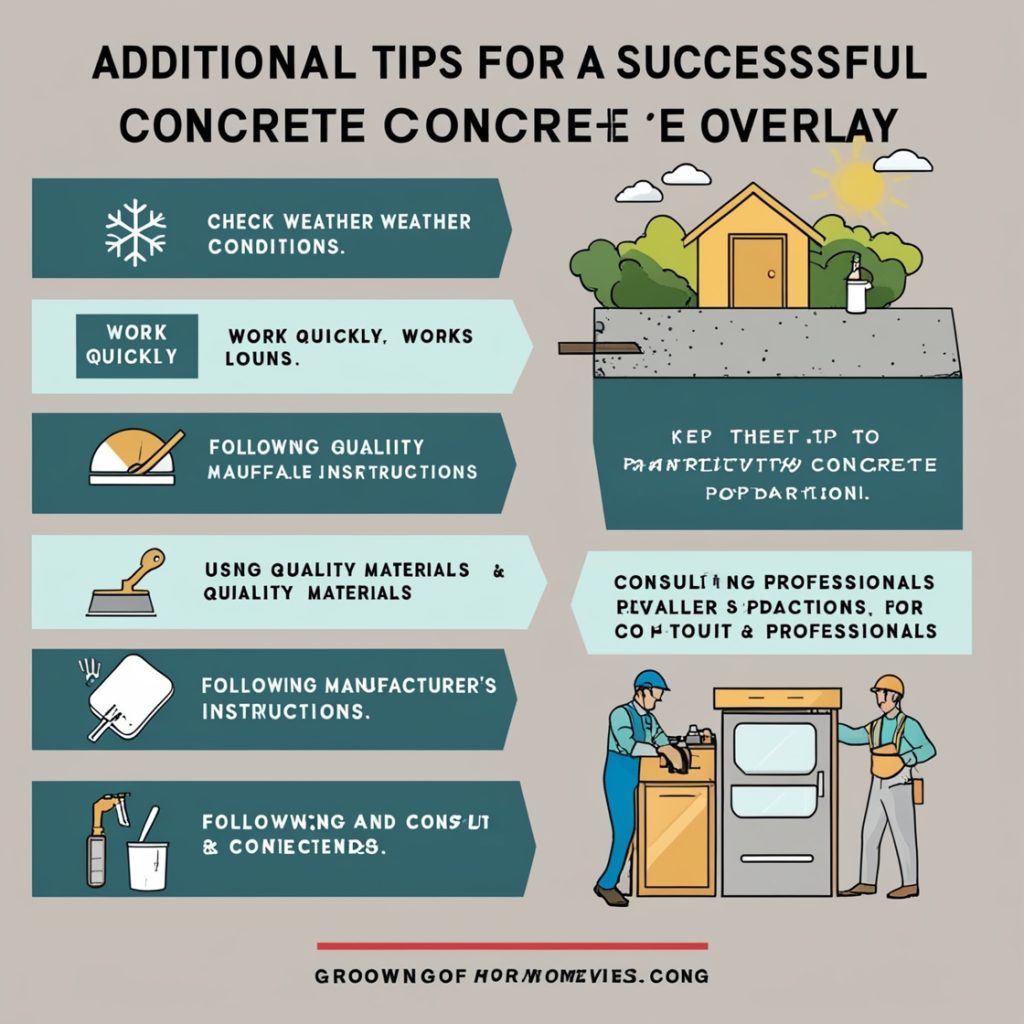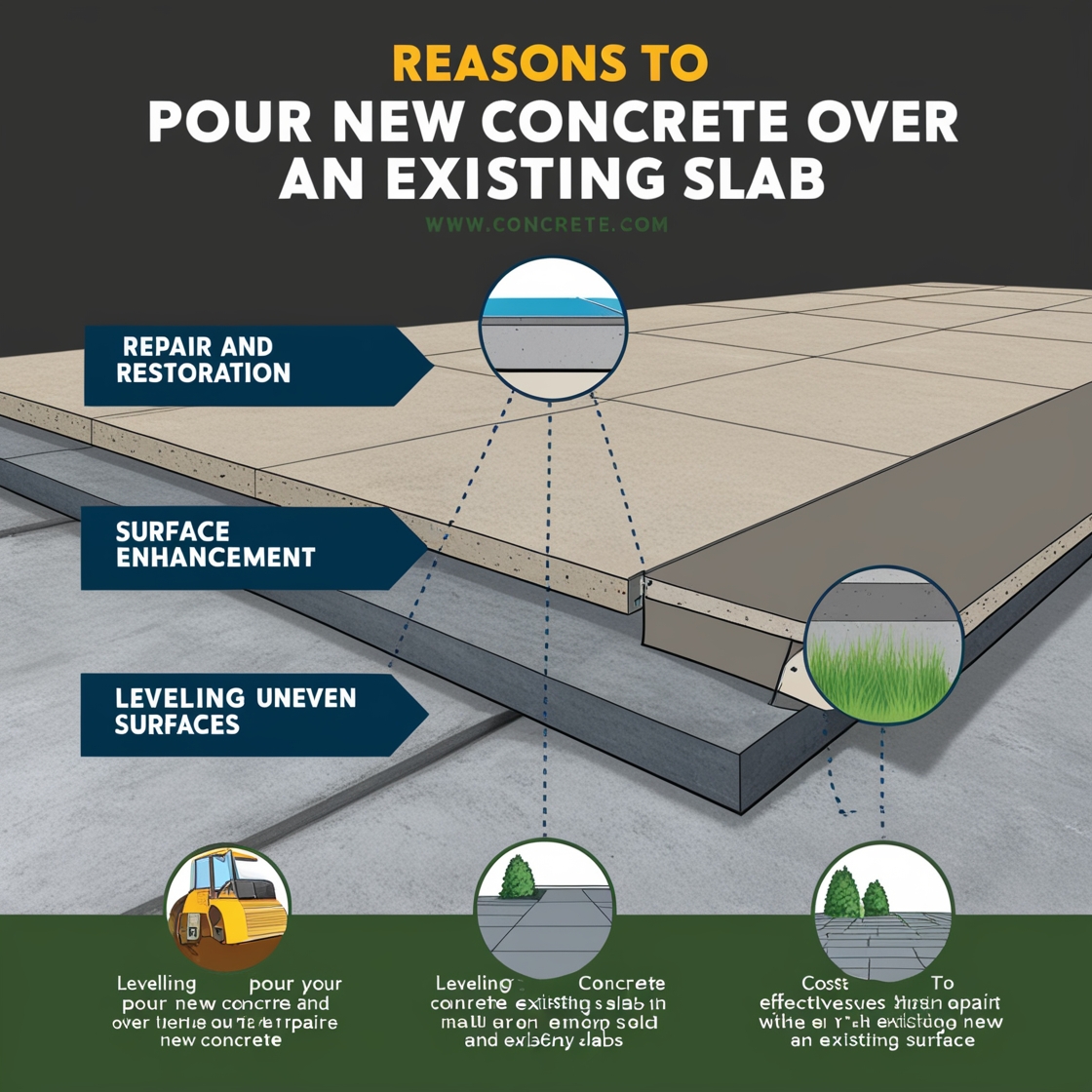Pouring concrete on concrete slab is an excellent solution for fixing or upgrading surfaces without the need to remove the old slab. This process, known as a concrete overlay, offers several advantages. It can refresh the look of worn or damaged surfaces, making them appear new and attractive.
Whether you’re dealing with a cracked driveway, an outdated patio, or a commercial floor that needs a facelift, a concrete overlay can provide a durable and visually pleasing finish. This system not only improves the appearance but also extends the lifetime of the concrete. To achieve the best results, it’s crucial to follow the correct steps.

The process begins with thorough preparation, including cleaning the existing slab, repairing any cracks or holes, and applying a bonding agent to ensure a strong bond between the old and new concrete. After preparation, you’ll pour the new concrete and finish it with the desired texture or pattern.
By adhering to these steps, you can ensure that your concrete overlay will be successful, providing both functionality and an enhanced aesthetic. This guide will help you understand how to effectively pour concrete on concrete slab, covering everything from initial preparation to the final finishing touches.
Why Choose Pouring Concrete on Concrete Slab?
Here are some reasons why you might choose pouring concrete on concrete slab:
- Fixing Damage: Pouring new concrete on top of an old slab is a great way to fix cracks, stains, and other problems. If your old concrete has ugly marks or breaks, adding a new layer can cover them up and make it look smooth and brand new. It’s like giving your old concrete a fresh start!
- Improving Appearance: With a new layer of concrete, you can make your space look really nice. You can add fun colors and cool patterns to your surface, making it look much better. It’s like decorating your concrete to match your style and make it look special.
- Leveling Uneven Surfaces: Sometimes, old concrete can get uneven or bumpy. If your slab has dips or lumps, pouring a new layer of concrete can help make it flat and smooth again. This helps make your surface safer to walk on and looks better too.
- Saving Money: Pouring new concrete on an old slab can be cheaper than taking out and replacing the old one. Removing the old concrete can be expensive and messy, but adding a new layer costs less and is quicker. It’s a smart way to make your concrete look great without spending a lot of money.

Preparing for Pouring Concrete on Concrete Slab
To make sure the new concrete sticks well and works properly, follow these steps to prepare your old slab:
- Clean the Surface Start by cleaning the old concrete slab. Remove dirt, debris, oil, and grease. You can use a pressure washer or a wire brush with a cleaning solution. Let the slab dry completely before moving on.
- Fix Cracks and Holes Check the old slab for cracks or holes. Fill them with a concrete repair product or patching compound. For larger cracks or holes, use a concrete patch or epoxy. Make sure these repairs are smooth and even with the rest of the surface.
- Roughen the Surface To help the new concrete stick, you need to roughen up the old slab. Use a special solution or a grinder to create a textured surface. This step is important when pouring concrete on concrete slab to ensure a strong bond.
- Apply a Bonding Agent Use a bonding agent or primer made for concrete overlays. Apply it with a roller or brush, following the instructions. This bonding agent helps the new concrete stick to the old surface.
Pouring Concrete on Concrete Slab: The Process
Once the old slab is ready, you can start pouring and finishing the new concrete:
- Mix the Concrete Follow the instructions that how to mix the concrete. Use pre-mixed concrete or mix your own with cement, sand, and gravel. For overlays, you might need a special mix for thin layers. Make sure it’s smooth and lump-free.
- Pour the Concrete Pour the new concrete onto the prepared slab, starting from one end and moving across. Use a shovel or rake to spread it evenly and fill in any low spots. Work in small sections to prevent the concrete from setting before you finish.

- Level and Smooth the Surface Use a screed board or a straightedge to level the concrete. Move it back and forth to remove extra concrete and fill in dips. Once it’s level, use a trowel or float to smooth the surface and get the finish you want.
- Add Texture or Patterns If you want to add texture or patterns, do it while the concrete is still wet. Use stamps, brushes, or other tools to create the effect you like. Follow the instructions for any decorative techniques you choose.
- Cure the Concrete Proper curing is important for the strength and durability of the new concrete. Keep it moist and protect it from extreme temperatures for at least a week. Use curing compounds, wet burlap, or plastic sheeting to maintain moisture and prevent cracking.
Tips for Successfully Pouring Concrete on Concrete Slab
To ensure the best results, keep these tips in mind:
Check the Weather
Before you start pouring concrete, check the weather to make sure it’s just right. If it’s too hot, too cold, or raining a lot, the concrete might not set properly. The best time to pour concrete is when it’s nice and dry, with mild temperatures. This means the weather is neither too hot nor too cold, and there’s no rain. Good weather helps the concrete dry evenly and look nice.
Work Quickly
Concrete sets up fast, so you need to move quickly! After you pour the concrete, you have to finish spreading and smoothing it before it starts to harden. If you don’t work fast enough, the concrete might start to set before you can get it smooth. Working quickly helps you get a nice, even surface that looks great.
Use Quality Materials
Always use good-quality concrete and bonding agents. Quality materials are like using the best ingredients when you bake a cake—they help make sure everything turns out well. Good concrete and bonding agents make your new layer strong and long-lasting. If you use cheap or low-quality materials, your concrete might not look as good or might not last as long.

Follow Instructions
Each concrete mix and bonding agent comes with instructions. It’s important to read and follow these instructions carefully. They tell you how to mix everything properly and how to use it. Following the instructions helps you get the best results, so your concrete overlay turns out just right.
Ask for Help
If your project is big or you’re not sure what to do, it’s okay to ask a professional for help. A concrete contractor is like an expert who knows a lot about concrete. They can give you advice and make sure everything is done correctly. Getting expert help can make your project easier and more successful.
Conclusion
Pouring concrete on concrete slab is a practical and affordable way to refresh and enhance your surfaces. By following these steps carefully, you can achieve a smooth, durable, and good-looking result. Whether you’re fixing a driveway, updating a patio, or adding a new layer to a commercial floor, these guidelines will help you get the job done right. With careful planning and execution, your new concrete layer will provide years of reliable performance and improved appearance.
If you want to know about What is Concrete Made Of?, click here
FAQs
Pouring concrete on concrete slab means adding a new layer of concrete on top of an old concrete surface. This can help fix problems and make the surface look better.
You might do this to cover up cracks, stains, or bumps. It also makes the old slab look new again and can add cool designs or colors.
The best time is when the weather is not too hot, too cold, or rainy. Mild and dry weather helps the new concrete dry properly.
First, clean the old slab well to remove dirt and grime. Fix any cracks or holes and make the surface a bit rough so the new concrete will stick well.
You should use high-quality concrete and bonding agents. These help the new layer be strong and last a long time.
Follow the instructions on the concrete mix package. Mix it until it’s smooth and without lumps. This will help it spread easily.
Pour the new concrete on the old slab, starting at one end and spreading it evenly. Make sure to cover the whole area.
Work quickly! Concrete starts to harden fast, so make sure you finish spreading and smoothing it out before it sets.
Use a flat tool, like a trowel, to smooth out the concrete. Move it back and forth to make the surface even and nice.
Keep the new concrete moist and protect it from extreme temperatures for at least a week. This helps it become strong and not crack.
